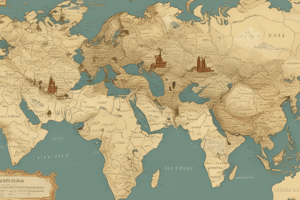Podcast
Questions and Answers
What was the Silk Road?
What was the Silk Road?
- A river connecting Asia and Europe
- An ancient trade route between China and the Mediterranean Sea (correct)
- A highway for modern transportation
- A military route used by emperors
What was the time period of the Silk Road?
What was the time period of the Silk Road?
130 BCE until 1453 CE
Where did the Silk Road stretch through?
Where did the Silk Road stretch through?
Asia, connecting China, India, Mesopotamia, Arabia, Egypt, Africa, Greece, Rome, and even Britain
Who pioneered the Silk Road?
Who pioneered the Silk Road?
The process of creating silk was a well-known practice outside of China.
The process of creating silk was a well-known practice outside of China.
What are caravans?
What are caravans?
Camels could carry heavy items over mountains.
Camels could carry heavy items over mountains.
What are oasis towns?
What are oasis towns?
Some products that traveled to China included _____.
Some products that traveled to China included _____.
Ideas that traveled to China included _____.
Ideas that traveled to China included _____.
Some products that traveled from China included _____.
Some products that traveled from China included _____.
Diseases that spread along the Silk Road included _____.
Diseases that spread along the Silk Road included _____.
What were some dangers on the Silk Road?
What were some dangers on the Silk Road?
Who was Marco Polo?
Who was Marco Polo?
What were the two ends of the Silk Road?
What were the two ends of the Silk Road?
Why did the Silk Road begin?
Why did the Silk Road begin?
What is a fable?
What is a fable?
Why did sea trade become more popular than land travel?
Why did sea trade become more popular than land travel?
Flashcards are hidden until you start studying
Study Notes
Silk Road Overview
- Ancient trade route linking China to the Mediterranean, approximately 6,440 km (4,000 mi) long.
- Connected China with the Roman Empire, famously traveled by Marco Polo.
Silk Road Time Frame
- Active from the Han Dynasty around 130 BCE until 1453 CE when the Ottoman Empire closed the routes.
Geographical Reach
- Spanned multiple regions including China, India, Mesopotamia, Arabia, Egypt, Africa, Greece, Rome, and extended to Britain.
- Included both overland and maritime trade routes.
Historical Context
- Zhang Qian contributed to the establishment of the Silk Road between 138-125 BCE during the Han Dynasty.
- The route’s highest traffic occurred during the Yuan Dynasty from 1271 to 1368 CE, under Mongol rule.
Silk Production
- Silk production was a closely guarded Chinese secret, with severe penalties (death) for attempting to export silkworms or eggs.
Caravans and Travel
- Caravans provided safety in numbers for travelers over long distances.
- Camels were commonly used, but their carrying capacity limited trade items to smaller goods due to geographical challenges.
Oasis Towns
- Oasis towns served as essential stops for caravans, offering supplies, rest, and sustenance; many evolved into prosperous cities.
Trade Goods to China
- Key imports included wool cloth, gold, silver, ivory, precious stones, and various agricultural products like cucumbers and pomegranates.
Ideas and Culture Exchange
- Notable ideas that reached China included winemaking techniques and Buddhism.
Exports from China
- Major exports were silk, gunpowder, paper, furs, ceramics, and spices like cinnamon and rhubarb.
Disease Transmission
- Diseases such as measles, smallpox, and the bubonic plague spread along the Silk Road, affecting populations across regions.
Dangers of the Silk Road
- Travelers faced numerous hazards including deserts, treacherous mountain passes, sandstorms, and threats from thieves awaiting vulnerable traders.
Marco Polo's Journey
- An Italian explorer who documented his travel experiences in Central Asia and China from 1271 to 1295 CE.
Silk Road's Length and Ends
- Spanning 4,000 miles, it originated in Rome and concluded in China.
Origin of the Silk Road
- Initiated by Roman curiosity for silk and an eagerness to locate the "silk people"; many expeditions failed to return due to desert challenges.
Fables Along the Silk Road
- Fables conveyed moral lessons, often highlighting consequences stemming from behaviors.
Shift to Sea Trade
- Sea trade became more favorable due to faster travel times (approximately 6 months vs. a year over land).
- Despite the risk of pirate attacks, many preferred the speed of maritime routes over traditional land passages.
Studying That Suits You
Use AI to generate personalized quizzes and flashcards to suit your learning preferences.



